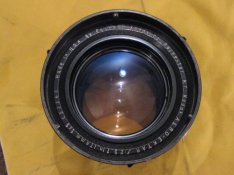Hi,
I finally managed to hack a mount for Aero Ektar 178/2.5 for my 4x5 Speed Graphic, and yesterday I took some test shots.
Aside from the subject(s) who wouldn't stand still, I noticed rather strange bokeh in the upper part of photos - see attached scans.
I admit I haven't seen many Aero Ektar shots before (only David Burnett's campaign shots and a few shots from Frank Peronio, all online), but these look strange...
Are those harsh "circles" normal? I suspect the lens might have been disassembled and incorrectly assembled again... Since such "effects" are usually result of improper spacing between elements or incorrect orientation of one of the elements...
Both elements on my lens look relatively OK (apart from some imperfections in the back element, like tiny drops/smudges of oil).
Any ideas as to reason for such harsh bokeh artifacts?
Just the way Aero Ektar behaves, or should it be better?
Regards,
Denis
PS: Efke PL100, Rodinal 1+60, 5 minutes, JOBO processor (high speed )
)
I finally managed to hack a mount for Aero Ektar 178/2.5 for my 4x5 Speed Graphic, and yesterday I took some test shots.
Aside from the subject(s) who wouldn't stand still, I noticed rather strange bokeh in the upper part of photos - see attached scans.
I admit I haven't seen many Aero Ektar shots before (only David Burnett's campaign shots and a few shots from Frank Peronio, all online), but these look strange...
Are those harsh "circles" normal? I suspect the lens might have been disassembled and incorrectly assembled again... Since such "effects" are usually result of improper spacing between elements or incorrect orientation of one of the elements...
Both elements on my lens look relatively OK (apart from some imperfections in the back element, like tiny drops/smudges of oil).
Any ideas as to reason for such harsh bokeh artifacts?
Just the way Aero Ektar behaves, or should it be better?
Regards,
Denis
PS: Efke PL100, Rodinal 1+60, 5 minutes, JOBO processor (high speed
 )
)





